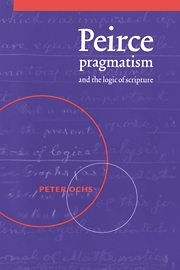Book contents
- Frontmatter
- Contents
- List of abbreviations
- PART I Peirce's pragmatic writing
- 1 Introduction: reading Peirce's pragmatism
- 2 Pragmatic methods of reading and interpretation
- 3 Problems in Peirce's early critique of Cartesianism
- 4 Problems in Peirce's early theory of pragmatism
- 5 Problems in Peirce's normative theory of pragmatism, 1878–1903
- 6 A pragmatic reading of Peirce's lectures on pragmatism
- PART II Peirce's pragmaticist writing
- Notes
- Index
1 - Introduction: reading Peirce's pragmatism
Published online by Cambridge University Press: 22 October 2009
- Frontmatter
- Contents
- List of abbreviations
- PART I Peirce's pragmatic writing
- 1 Introduction: reading Peirce's pragmatism
- 2 Pragmatic methods of reading and interpretation
- 3 Problems in Peirce's early critique of Cartesianism
- 4 Problems in Peirce's early theory of pragmatism
- 5 Problems in Peirce's normative theory of pragmatism, 1878–1903
- 6 A pragmatic reading of Peirce's lectures on pragmatism
- PART II Peirce's pragmaticist writing
- Notes
- Index
Summary
Even though many of his contributions to the discipline may still appear idiosyncratic, Charles Peirce's name no longer needs introduction to an audience of professional philosophers. For many years after his death in 1914, Peirce's largely unpublished works were known only to a band of devotees – or known only second-hand through the works of those he influenced, such as William James, John Dewey, Charles Hartshorne and Paul Weiss. Now, however, Peirce's innovations in the theory of language and of signs (he called it semeiotic), in phenomenology, in the logic of relations, in the philosophy of mathematics and in pragmatism have been the subject of dozens of scholarly books, hundreds of essays, and have begun to enter into the standard curricula of graduate schools in philosophy. Beyond the profession, an increasing number of literary scholars, hermeneuts, theologians, and postmodern theorists of various descriptions find themselves surveying the secondary literature, and also venturing into Peirce's labyrinthine corpus.
I address this study of Peirce, first, to members of this latter group. I imagine they may have turned to his work for some of the reasons I first did, twenty years ago, when I was studying the philosophy of rabbinic thinking, as displayed in the literature of classic Judaism: the Talmud and the midrash in particular (the collections of rabbinic interpretations of biblical narrative and biblical law that were compiled, roughly, in the 1st–6th centuries, in what were then Babylonia and Palestine).
- Type
- Chapter
- Information
- Peirce, Pragmatism, and the Logic of Scripture , pp. 3 - 19Publisher: Cambridge University PressPrint publication year: 1998



